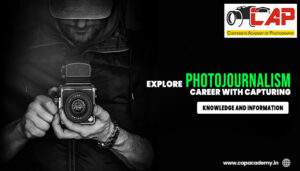When a student in Kolkata looks for the best photography institute in Kolkata, one thing always causes worry: “Will the course really help me get noticed locally & beyond? Many students invest time and money, only to see their work remain hidden in the circle of friends and relatives. They struggle with weak portfolios, no recognition outside the city, and no real path to exposure.
This blog shows exactly what a photography course in Kolkata should include, so that learners build a strong portfolio and gain global exposure. If your institute offers these, you stand out. If you choose a course, use this as your checklist.
Why portfolio and exposure matter
A portfolio acts as a mirror of skill, style, and growth. It tells potential clients or institutions what a photographer stands for. Many talented students lose opportunities because their portfolios lack direction. Images may look technically sound but miss emotional or conceptual clarity. Some present only one type of work, making them appear less versatile.
Global exposure, on the other hand, builds recognition. Without visibility beyond the local circle, even the most creative photographers struggle to grow. Limited exposure means fewer projects, smaller earnings, and slower progress. Photography courses in Kolkata must address these pain points. They must help learners create structured, meaningful portfolios and build the confidence to present work on global platforms.
What a strong portfolio must include
A successful portfolio includes variety, skill, and storytelling. It shows growth, not repetition. The following elements define a complete portfolio that attracts clients and institutions worldwide.
1. Work in multiple genres
If your portfolio only shows landscapes, you may lose chances in commercial, fashion, or documentary work. A course needs to push you to try portrait, street, still life, documentary, travel, fine art. This gives flexibility.
2. Personal narrative / thematic project
You must have at least one project of your own idea. Pick a theme, plan shoots, execute, edit, and present. That shows your voice, clarity, and commitment.
3. Technical strength + post processing
Many students take photos but lack editing skills. A course should teach RAW editing, color correction, retouching, compositing, and other tools well. If your portfolio’s editing is weak, viewers get a bad impression.
4. Curation & sequence
A portfolio is more than many images. The order matters. The flow, mood shifts, consistency; all of these must be taught. A mistake many make: random pictures without any structure.
5. Presentation in varied formats
Your work should appear in print, photobooks, exhibitions, and online galleries. Some clients prefer print. Some judges prefer seeing work in real space. Courses must help you with both.
6. Feedback, critique & iteration
No one grows in silence. You need regular reviews from instructors or visiting photographers. Peer feedback, too. You must revise, improve, and re-present. Without this, your portfolio stagnates.
Top Ways to Achieve Global Exposure?
Even if your work is good, it needs channels. A photography course must build bridges. Here’s what it should include:
1. Collaboration & exchange programmes
Work with students from other countries or cities. Share projects across borders. Show you can handle cross-cultural work.
2. Submissions to international contests & festivals
Courses must support you in entering festivals, exhibitions, as well as photo contests abroad. They should guide how to write an artist statement, send a proposal, and manage submissions.
3. Presence on global digital platforms
Your institute must teach you how to use sites like Behance, 500px, Flickr, or international magazines. Also, teach SEO, metadata, captioning, and hashtags. If your work is invisible online, it is as if it does not exist.
4. Guest lecturers & portfolio reviews
Invite photographers from other countries to review student work. Their feedback adds credibility. It also gives you contact points outside Kolkata.
5. Publishing opportunities
Work with magazines, journals, art zines: both local & international. Or self-publish small photo books that can be shipped. The course should help you research these and pitch your work.
6. Networking, conferences & workshops
Encourage students to attend national or international photography meets. Create tie-ups with galleries, museums. This helps students present work beyond the classroom.
What a Modern Kolkata Photography Course Should Offer?
Photography courses in Kolkata should follow a forward-looking structure to prepare students for global opportunities-
Projects with global potential
Learners should complete the course with a project ready for contests or exhibitions. Photography institutes need to train candidates on selecting the right topic. The team should be able to help scholars learn how to research.
Portfolio Marketing
Teaching how to present work to galleries, agencies, as well as clients is quite significant. Students should learn professional communication or proposal writing without losing creative integrity.
Submissions & Showcasing
Institutes can create dedicated teams to guide students through the process of submitting work to exhibitions or online platforms. Support in curating entries as well as meeting deadlines saves time and prevents errors.
Mentorship Network
Mentorship from national & international photographers adds real value. A strong alumni network and visiting experts help students stay connected & informed long after graduation.
Interdisciplinary Collaboration
Combining photography with design & cultural studies brings new ideas. Collaborative projects teach teamwork and practical application, skills that help in future jobs.
Digital Support System
Institutes should offer access to digital tools & portfolio hosting facilities. This helps students maintain an updated and professional online presence.
Business Proficiencies
A decent photographer must also understand copyright & pricing. Training in business communication & client management prepares students for real work situations.
Challenges & Real Risks
Building such an advanced system requires trained staff as well as commitment. Here are the key challenges-
- Many institutes in Kolkata lack funds or external tie-ups, so they struggle to maintain global links.
- After course ends, students often get no help. They are left alone to fend for themselves.
- Some courses pressure students to create work that “sells” rather than work they believe in. That kills creative identity.
- Students may not know copyright, licensing, intellectual property rights. A course must teach these.
- Infrastructure (studio, equipment, travel support) often limits how far students can reach.
How Students Can Select the Right Course?
Choosing the right institute is as important as choosing the right camera. Students should compare course content & exposure opportunities before making a decision.
Below are key points to check before enrolling:
Portfolio guidance
The course should include training on creating and presenting a professional portfolio.
Exposure opportunities
Look for chances to submit work to exhibitions or global platforms.
Mentorship
Check if there are guest sessions, alumni guidance, or expert reviews.
Digital presence
Courses must help with building personal websites or online galleries.
Business awareness
A good course includes basic lessons on pricing & marketing.
Alumni success
Past student achievements reflect the institute’s commitment.
Post-course support
Constant mentorship after graduation adds long-term value.
Students should ask clear questions before enrolling:
Will the course help in showcasing work internationally?
Is there guidance for exhibitions and competitions?
What kind of feedback and mentorship will be available?
An institute that answers these questions transparently stands closer to being the best photography institute in Kolkata.
A Sample Learning Framework
Here is an outline of what each semester (or module) might cover:
| Module | Focus | Outcomes |
| Foundations | Camera settings, light, composition | You can shoot technically correct images |
| Genre explorations | Portrait, street, still life, nature | You build variety |
| Narrative projects | Your own themed project | You produce a voice & story |
| Editing & post | RAW workflow, retouching | Your images look professional |
| Curation & display | Sequence, print, photobook, online | You present with impact |
| Exposure & submission | Contests, publications, guest reviews | You get visibility |
| Business & outreach | Client pitching, contracts, pricing | You learn to monetize |
| Capstone + global showcase | Final project + exhibition/online launch | You leave with a presence |
If a course lacks any of these, it is incomplete.
Why does this Matter for Your Future?
Photography as a career thrives on both talent & visibility. But many students finish courses with a stack of photos but no jobs. Their talents stay hidden. They feel frustrated. A poor portfolio and weak exposure block their chances to work with magazines, agencies, galleries, or clients abroad.
Without a portfolio that communicates skill and without platforms that provide reach, talent stays unnoticed. A comprehensive course that combines creative practice with exposure support helps break it.
A course that prepares you beyond technique into visibility & reach gives you a chance to be seen, appreciated, & hired. When your work reaches audiences outside Kolkata, your name grows. You get collaborations & recognition. That is how you break free from the local plateau.
Final Thoughts
Kolkata has always been known for its artistic spirit. With the right education structure, it can also become a hub for global photographic talent. Courses that teach portfolio building, global exposure, and professional readiness will give students the edge they need.
If a photography institute in Kolkata claims to be great but ignores portfolio marketing or global exposure, that is a red flag. Choose a course that connects you to the world & supports your first steps into the wider arena.
Aspiring photographers deserve education that values creativity & skills. Students can step confidently into a global stage when institutes focus on all these.











